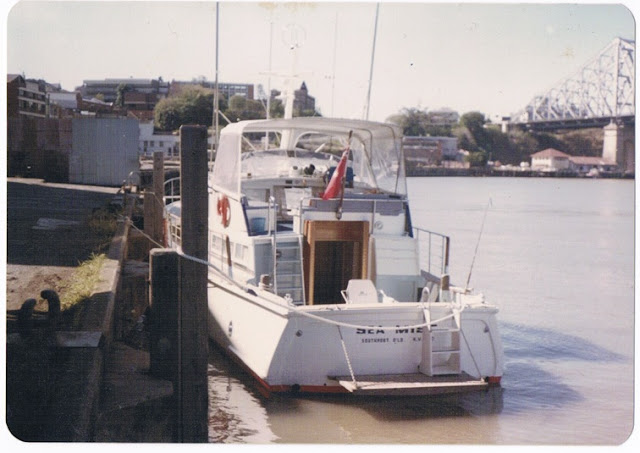 |
| "Sea Mist" tied up near Customs House, Brisbane - 1979 |
I had known a little bit about Sea Mists's involvement in the famous "Attack on Sydney Harbour", through my family, but seeing her again prompted me to dig a bit deeper - and I discovered a wealth of literature on this very historic and symbolic moment, in the arrival of the war to our shores..
Nonetheless, there was no extra or special vigilance on Sydney Harbour on the evening of 31 May. It was a Sunday night with the typical "end of the weekend" atmosphere. It was rainy, overcast and cold. There was plenty of movement around the city, with people making their way home and there was hustle and bustle in the areas populated by sailors - there were reportedly over 80,000 US Servicemen in Australia at the time.
The floodlights were on at Garden Island and there was a hive of activity on the harbour, with vessels coming and going and ferries doing their usual runs. Indeed the harbour was full of ships - more than at any other time of the war, with over 30 naval vessels and several large commercial ships.
The sun went down at 5pm and an air of calm descended on the harbour - the calm before the storm - for just outside the heads of Sydney Harbour, three of Japan's largest ocean going I class submarines were launching three potentially lethal Ko-hyoteki-class"midget" submarines on the unsuspecting city, with a further two submarines in support and a total of 500 Imperial Japanese navy personnel in total. Their mission was to inflict as much damage as possible on major allied ships.
The three midget submarines, the M24, M21 and M27, were released from the three larger submarines - two of which had launched midget submarines into Pearl Harbour in the famous shock attack, just six months previous. Each of the midgets were 24 meters long (80 foot) with a two member crew, two torpedoes and with a 12 hour range, submerged.
The Japanese had intended to destroy several major warships moored in the harbour; among these were the three major, heavy cruisers, the USS Chicago, HMAS Canberra and the HMAS Adelaide; along with several other destroyers, minelayers, corvettes and armed merchant cruisers.
 |
| USS Chicago |
The M24 was not so unlucky - following a Manly ferry through the boom defences - it recorded inward crossings on an "indicator loop" at 9:48pm.
At 10.50pm an Ensign aboard the large warship, the USS Chicago, saw the M24's periscope 500 meters away. He opened fire with his .45 pistol before the submarine was illuminated by the Chicago and then subjected to a torrent of shells, both from the Chicago and other corvettes - which proceeded to pursue the intruding submarine around the harbour, much to the shock of passengers on small craft in the vicinity. The submarine submerged to escape attack. Despite the potential danger to civilian craft, remarkably, ferries were allowed to keep running; Rear Admiral Muirhead-Gould believed:
"...the more boats that were moving about at high speed, the better chance of keeping the submarines down till daylight."Avoiding its pursuers, at 12.30am, M24 re-surfaced and took aim at the USS Chicago. It fired its torpedoes. The first went astern of the Chicago, passed under the Dutch submarine K9, and slammed into the HMAS Kuttabul, a converted ferry come accommodation vessel. The torpedo ripped through the Kuttabul, exploding it in two and sending large chunks of its hull skyward in a thunderous concussion. Twenty-one (21) sailors were killed, with a further ten injured. (The ultimate retrieval of the corpses took some time and was one of the more confronting scenes of the war on the domestic front).
 |
| HMAS Kuttabul... sunk by the Japanese. 21 people perished. It was several days before they could all be recovered. |
 |
| Unexploded torpedo from the Japanese midget sub, M24 |
"Enemy submarine is present in the harbour and Kuttabul has been torpedoed."
The channel patrol boats were dispatched. "Tomaree" to the East boom gate. "Steady Hour", "Lolita" and "Yarroma" were sent to the boom. "Marlean" and "Sea Mist" were sent to the West.
M24 made its way for the heads - a crossing was later identified at 1.10am - one and a half hours after firing its torpedoes... At 3am the Chicago left the harbour and as it was leaving, it identified a periscope, almost alongside. The M21 was making a belated entry... The Chicago signalled Garden Island:
"Submarine entering the harbour."There was now a concerted effort to find this and any other midget submarine in the harbour.
For several hours there had been pandemonium - sirens were sounding, searchlights, flares and tracer fire arced overhead. There were so many navel vessels swarming across the harbour and such frequent explosions of depth charges and gunfire, it was somewhat miraculous there were no collisions or accidents...
It is reported that Sydneysiders displayed a variety of reactions to the action. Some went about their business - others hurried to the nearest air-raid shelter, while others still rushed to the nearest vantage point to see what all the commotion was about...
For the next two hours, there were intermittent sitings near Taronga Zoo and Bradley's Head, but it wasn't until 5am that M21 was discovered by "Sea Mist", in Taylor's Bay.
 |
| A rare photo believed to show one of the depth charges being dropped in the harbour on the morning of 1 June, 1942. |
Sea Mist confirmed the object as a submarine and dropped a critical depth charge into its frothing wake, set for 30 metres. This blew the midget submarine to the surface. Attacking again as it sunk, Sea Mist's captain, Lt Andrew dropped a second bracket of shallow-set depth charges, set at 15m, which only allowed his boat 5 seconds to clear... It didn't quite make it - lifted by the stern by its own explosion, Sea Mist's engines were disabled. In the process, however, it had floundered the Japanese sub.
While Sea Mist was out of action, the damage was done - the attack had brought the invading Japanese to peril. Not to be outdone though, "Steady Hour", the 56 foot Halvorsen, picked up where Sea Mist left off, continuing the assault and with other angry patrol boats joining it soon after, a further 17 depth charges were dropped on the wrecked sub. Crippled and laying on the bottom with its engine still running, the two Japanese crew members were dead. They had been unable to detonate the submarine's internal demolition charges...
 |
| HMAS Steady Hour - another Halvorsen - came to assist Sea Mist. |
 |
| The M21 midget submarine is retrieved from Taylor's Bay |
 |
| M27 trapped in netting during recovery |
"Our family had been told that our boat would be patrolling around New Guinea so it did come as a surprise to find out about her role in Sydney... I've only just found out that our cruiser played a crucial role in the sinking of the Japanese midget submarines... a good friend told me he had found that information on the internet..."
My uncle, John Donnelly, sold Sea Mist in the early 1980's to a Brisbane family - where it has called home ever since. As I understand, the same family has retained ownership. My cousins and I had spotted her in the Brisbane river once or twice in the 90's, looking a bit tired... In 1999, to celebrate her 60th, she underwent a comprehensive overhaul and re-fit.
 |
| "Odyssey" on the Broadwater, Gold Coast. |










